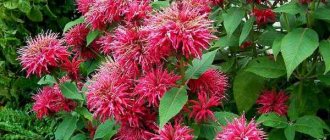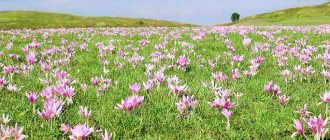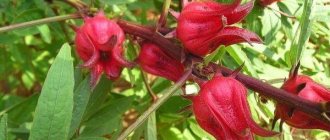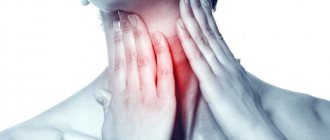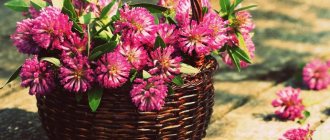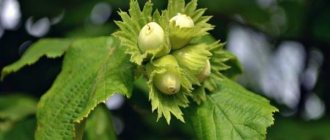Burdock is a hardy, fast-growing biennial. Its bitter-tasting but tender spring foliage is used as a vitamin-rich green. Up to 2.5 m high, this giant herbaceous plant with large oval leaves and numerous spherical baskets of purple flowers immediately attracts the eye.
Burdock 483
Burdock has both high nutritional value and outstanding healing qualities. But residents of the Northern Hemisphere, where burdock grows in vacant lots, roadsides and landfills, usually consider it a weed.
Other names:
- burdock
- felt burdock
Parts used:
- leaves
- roots
- seeds
Varieties
Some varieties of burdock (such as those obtained in Japan Takinogawa Long and "Watanabe Early") are bred as vegetable plants for their powerful, crunchy roots that go up to 1.3 m into the ground. The roots of both varieties taste like a cross between parsnip and Jerusalem artichoke (earthen pear).
Related article:
Diseases and pests of asters
What burdock looks like and its medicinal properties
Burdock is a tall biennial plant, sometimes reaching the average height of a man. The structure of the root system is well developed, the shape of the root resembles a spindle, and reaches 0.6-1.5 meters in length. A powerful, tall stem appears in the second year; in the first year, basal leaves grow.
Despite the large size of the plant itself, its flowers are distinguished by their small shapes. From a distance, burdock attracts attention with a large number of purple flowers. They tend to easily cling to fabric thanks to thin spines located over the entire area of the leaves framing the inflorescence.
Despite the large size of burdock, its flowers are distinguished by their small shapes.
There are also other types of burdock: cobwebby, small and 8 more species. Of all the varieties, the Sakhalin burdock stands out for its size, which local residents often use instead of an umbrella if the rain takes them by surprise. The nature of Sakhalin is so favorable for this plant that the leaves in diameter reach 1.5 meters, and the height of the grass is 3 meters. Only large burdock has beneficial qualities. First of all, it is worth highlighting honey, the pollen of which is collected from burdock. It has all the medicinal properties of the plant, has a pleasant smell and delicate taste.
In general, every centimeter of burdock has its own use, because every part of it contains valuable components.
Features of burdock as a medicinal plant
Burdock is a medicinal plant, although it is a weed. Most often, large and cobwebby burdock is prepared as a pharmaceutical raw material. What are the medicinal properties of this plant? What are the indications and contraindications for its use?
Burdock is felted, or woolly, cobwebby.
Small burdock.
Burdock.
Kinds
Burdock, like plantain and chamomile, is an easily recognizable medicinal plant. There are about 20 types of burdock. Of these, three species are most often used in folk and scientific medicine, which are similar in botanical characteristics and biological activity.
- Burdock is felted, or woolly, cobwebby. A biennial herbaceous plant with a fleshy, fusiform, thick, large root. Height: from 60 cm to 2 m (sometimes up to 3 m). The stem is strongly branched, erect, ribbed. The leaves are large at the bottom and become smaller up the stem. The bottom is grey-tomentose, the top is smooth and dark green. The peculiarity of this species is its cobwebby-fluffy stem and glandular-hairy flower baskets.
- Small burdock. Its morphological difference from other species: the baskets are collected in racemes and are larger in diameter. The height of the stem can be from 50 cm to 1.5 meters. Most common in Europe and Western Asia.
- Burdock. Other names for this species are also known: common burdock, or real burdock, burdock, burdock. According to botanical characteristics, it is similar to felt burdock. The average height is 1.5 meters. On moist, fertile soils it can grow up to 3 meters.
There are also many hybrid species that grow along roads. Formed in close growing conditions. In hybrids, it can be difficult to determine the characteristics of one species or another.
Area
The burdock plant's distribution range covers the whole of Eurasia. Its main species can be found not only in Europe, but also in Siberia, Asia, and China. It also grows in North and South America, Australia, and New Zealand as an alien species. In the Central Russian zone it is found everywhere. Loves weedy places. Belongs to ruderal (garbage) species. It takes root well in vacant lots, landfills, gardens, orchards, along roads, fences, and near housing. In the wild it forms tall thickets. It can often be seen in ravines, gullies, forest plantations, as well as along the banks of reservoirs, in willow forests.
Procurement of raw materials
Burdock has been known in folk medicine since ancient times. Ancient herbalists describe recommendations for its preparation.
Burdock. Botanical illustration from Martin Cilešek's book Naše škodljive rastline, 1892.
Collection. It is preferable to dig up the roots of the first year burdock in the fall. The healing properties are retained in plants of the second year, but they need to be dug up in early spring, before the stems begin to grow. The leaves and apical part are collected during the flowering period. Depending on the climate zone and species, collection may begin in June and end in September.
- Preparation and drying. The underground part is shaken off the ground, washed, cleared of bark, and thin roots are broken off from it. Then the roots are cut into plates up to 10 cm long (the total length of the root can reach 60 cm). It is recommended to dry in natural conditions - on verandas, attics with good ventilation, under awnings. The roots are laid out in a thin layer. The finished raw material should be brown on the outside and whitish-gray on the inside. Burdock leaves are dried in the same way.
- Storage. Some herbalists state that the leaves can be stored for 2 years, and the roots can be stored for 2 to 5 years. Under the right storage conditions (protect from dampness and light!), raw materials do not lose their beneficial properties for a long time.
Healing effect
What are the beneficial properties of burdock root?
- Blood purifying.
- Secretory.
- Antitumor.
- Antifungal.
- Diuretic.
- Sweatshop.
- Bactericidal.
- Wound healing.
- Anti-inflammatory.
- Disinfectant.
- Absorbable.
What does burdock root contain? The most valuable substance is the polysaccharide inulin. This carbon removes radionuclides, strengthens the immune system, normalizes liver function, stimulates hair and bone growth, promotes calcium absorption, and has a beneficial effect on lymphoid tissue. This substance is also found in chicory, Jerusalem artichoke, garlic, elecampane, dandelion, and asparagus.
In addition, the following were found in the root: mucus, proteins, essential oil, organic acids, fats, glycosides, trace elements, tannins, phytosterols, substances with antibacterial and antifungal properties. The leaves contain a lot of mucus, tannins, essential oil and vitamin C.
Indications for use
What does burdock root cure? For what diseases is it most often used?
- Treatment of joints and bones with burdock. It is useful to drink for rheumatism, radiculitis, arthrosis, osteochondrosis, gout, rickets. It relieves inflammation in joints, strengthens bones, and soothes pain. Taken orally, used externally in the form of compresses, baths and rubbing.
- Treatment with burdock of the gastrointestinal tract. The mucus contained in the herb is beneficial for the stomach and intestines. Infusions are drunk for chronic gastritis, stomach ulcers, to stop gastric bleeding, for digestive disorders, constipation, and hemorrhoids. Burdock has choleretic properties; it can be taken for gallstones, inflammation of the pancreas, and gallbladder. The herb also has antihelminthic properties.
- Treatment of kidney cysts with burdock. The root of the plant contains substances with absorbable properties. Burdock inhibits the growth of benign tumors in the body of various locations and nature. As a diuretic, it is prescribed for kidney stones, edema, and inflammation of the urinary system.
- Treatment of respiratory diseases with burdock root. Decoctions and infusions are taken orally as an antipyretic and diaphoretic for ARVI, flu, colds, respiratory inflammation and cough.
- Application in gynecology. Recommended for delayed periods to normalize the menstrual cycle. Burdock is also drunk for ovarian cysts and uterine fibroids.
- Application in endocrinology. The plant improves all metabolic processes in the body. Useful for diabetes (under medical supervision!). The plant improves the functioning of the pancreas and the production of insulin. There are quite a lot of positive reviews about taking burdock root for weight loss. The product cleanses blood, lymph, urine, rejuvenates the entire body, removes toxins and waste.
- Burdock root for oncology. Most often used for gynecological oncological diagnoses, stomach and esophageal cancer. Burdock is effective against cancer in the initial stages. It is also recommended to drink it to prevent malignant tumors, especially in old age.
- External use. Decoctions, ointments, tinctures, juice are used to treat wounds, burns, boils, trophic ulcers, acne, eczema, lichen, dermatitis, erysipelas, bruises, hemorrhages. Burdock also helps with mastopathy and neuralgia. It is used to treat the throat and oral cavity for inflammation.
- Detoxifying agent. It is useful to drink for various poisonings - food, alcohol, chemicals, heavy metals and poisons. There are positive reviews of burdock root as an antidote for bites from poisonous animals and insects.
There are few contraindications for burdock root. In rare cases, individual intolerance and an allergic reaction to the grass may occur. It can be used with caution and only after consulting a doctor during pregnancy, lactation and childhood. Also, in case of exacerbation of all diseases of the gastrointestinal tract and urinary system, medical consultation is required before taking it.
Gallery: burdock (25 photos)
The use of burdock root in folk medicine and cosmetology
The root of the plant contains a whole complex of useful substances: starch and protein, various oils, acids and resins, vitamins, minerals and many other elements.
Also read: Barbados cherry: uses of acerola in cooking and medicine
Preparations containing burdock root are used to remove excess fluid from the body through urination, sweating, as a choleretic and mild laxative, and as a supporting element for the pancreas. For external use, ointments and decoctions are used to relieve allergy symptoms, eliminate itching, and to provide first aid if an antimicrobial, antiseptic or disinfectant effect is necessary.
Let's look at the description of recipes made from burdock rhizomes, indicating the diseases for which it is used. It is immediately worth noting that contraindications are present only for pregnant and lactating women , as well as for individual intolerance to mental illness.
Burdock root contains a whole range of useful substances
- Allergy. Any form of root (dried or fresh) is filled with cow's milk. For 10g of burdock, take a glass of liquid (0.25l). Leave over low heat in a water bath for a couple of hours, without letting it boil. To do this, do not cover with a lid. Then let it brew for the same period of time and strain. Take 2 tbsp. l. several times a day (at least 5) regardless of meals.
- Gastritis. Grind the burdock roots, pour a third of a tablespoon into 0.2 liters of boiling water. Leave for half a day, strain. Take 100g before meals 4 times.
- Scrofula. Leave a decoction of the roots (proportions as for gastritis) for 1/3 hour, strain. Drink a chilled drink as often as possible. Rubbing of sore areas is also recommended.
- Healing problematic wounds. The root is poured with vegetable oil in a ratio of 1:5, the mixture is infused for 24 hours, after which it is boiled over low heat for ¼ hour and decanted. Apply topically directly to the wound.
- Cardiac ischemia. The dry root is poured with boiling water, and the fresh root with cold water. Proportions: 2 tbsp. burdock, 500g liquid. It's night time. Drink 150g before meals ¼ hour or an hour after it.
There are many more ways to cure various diseases using burdock. In cosmetology, burdock oil, which is discussed in recipe No. 4, is actively used against hair loss. It is rubbed into problem areas to stimulate the hair follicles and blood circulation in them.
Burdock oil is actively used in cosmetology against hair loss.
Large burdock (burdock) - description, composition, medicinal properties,
———
Burdock (burdock) is a large biennial herbaceous plant growing up to 60-180 cm in height. The root is fleshy, taprooted, with few branches, up to 60 cm long; in the first year of life it is succulent, and in the second it becomes flabby and hollow inside. In the first year, burdock forms basal leaves, in the second - a powerful, erect, ribbed, reddish, highly branched stem. The leaves are petiolate, gradually becoming smaller towards the top of the stem. The lower leaves are large, up to 50 cm in length and width, and the upper ones are smaller. The flowers are collected in spherical baskets with a diameter of 3-3.5 cm, arranged in the form of a shield. All flowers are tubular, bisexual, with a lilac-purple corolla. The fruits of burdock are oblong, bare, ribbed, spotted achenes, 5-7 m long. Burdock grows as a weed near homes, in vacant lots, near roads, sometimes in clearings in forests, among shrubs throughout the steppe and forest-steppe zone. Burdock blooms in June —August. The fruits ripen in September-October. The medicinal raw materials are the leaves, thorns and roots of burdock.
The roots of first-year plants are dug up at the end of April - beginning of May, when the burdock does not yet have stems. The dug up burdock roots are cleaned from the soil with a soft brush, washed in water, dried and the above-ground parts at the root collar are cut off, then cut into pieces 5–10 cm long, and thick ones are also cut lengthwise. Flabby and woody roots are unsuitable for medicinal purposes. The succulent roots are dried in the sun. Dry burdock roots outdoors or in well-ventilated areas. In humid weather, the roots are dried in dryers at a temperature of 45–50°C. The dried roots are grayish-brown on the outside, pale gray at the break. The finished raw material breaks rather than bends and has a sweetish taste with a slimy feeling. Burdock leaves are often used fresh - for compresses, wraps and for extracting juice. The leaves for the preparation of medicinal infusions are collected during flowering in July-August, and dried in the shade under a canopy or in well-ventilated areas. Seeds - as they ripen. The shelf life of roots when properly stored is up to 5 years, seeds - 3 years, leaves - 1 year.
Burdock is a fairly common and simple plant for our latitudes. It can be found in a summer cottage, in a city under a house, in a forest or in a field. Despite its prevalence, burdock is a fairly useful plant with a wide range of uses in folk medicine.
Despite the fact that many people classify it as a weed, burdock has a huge amount of chemicals and elements that are beneficial to the body, and also has rich medicinal properties.
Burdock contains the following elements and substances:
| Medicinal properties of burdock:
|
With the help of burdock, you can not only cleanse the entire body of toxins, but even cleanse the blood. It is also known that burdock is capable of removing radionuclides and toxic substances from the body.
The most valuable substance in burdock is inulin (up to 45%). It actively takes part in metabolism. Thanks to the polysaccharide inulin, sugar levels are normalized, digestive functions are improved, and the immune system is strengthened. Also, this substance is an excellent preventative against the occurrence of diseases of the cardiovascular system and atherosclerosis.
Burdock seeds contain fatty oils. The leaves are rich in vitamins - C, E, as well as B vitamins, and also contain mineral salts (potassium, magnesium, selenium, phosphorus, calcium), there is a small amount of alkaloids, they delay the development of some tumors, its preparations have a cytostatic effect, then there are slow down the growth of tumor cells.
After severe poisoning or undergoing chemotherapy, this plant will help get rid of the aggravating consequences and will expel heavy substances and toxins in the near future.
|
|
Infusion: 1 tbsp. of dried roots, pour 1 cup of boiling water and leave for up to 10 hours under a closed lid in a warm place (you can use a thermos), filter and drink 1/4 cup 3 times a day before meals. For the treatment of gastritis , stomach and duodenal ulcers, and diseases pancreas.
An infusion of burdock root is effective for diseases of the gallbladder and liver.
Infusion: 2 teaspoons of crushed dry roots, pour 2 cups of boiling water over them, cover with a lid and boil in a water bath for 20 minutes, cool for 1 hour, then strain. Take 1/2 cup three times a day for diseases of the gallbladder and liver.
Problems with the digestive system, all kinds of colitis, gastritis, as well as problems with stool are successfully treated with decoctions of burdock seeds. How to brew? Pour two cups of boiling water over the burdock seeds and leave for 12 hours. Then strain thoroughly and drink after your meal.
Decoction: 1 tbsp. a spoonful of chicory root powder, dry bean pods and flax seeds, mixed in equal quantities, pour a glass of boiling water and leave in a water bath for 15 minutes. Cool for 45 minutes, strain and take half a glass 3 times a day, for diabetes
Decoction: 1 tbsp. spoons of dry root pour 1 cup of boiling water. The roots must be infused in a water bath for 15 minutes, strained, and brought to 200 ml with water. You need to take 1/2 cup twice a day, for bladder ,
with
cystitis.
Decoction: 1 tablespoon of dry burdock roots, pour 200 ml of hot water and leave in a water bath for 15 minutes, then cool, strain and drink 0.5 cups 2-3 times a day, for the treatment of prostate adenoma
Infusion: 1 tbsp. Pour 1 cup of boiling water over a spoonful of dried burdock roots. Then strain. The infusion should be taken warm, 1 glass twice a day, lying in the pastel and covered with a blanket, as a diaphoretic for colds and flu.
Decoction: 1 tbsp. l. dry burdock roots, pour a glass of boiling water, boil for 1 minute. Then leave for 40 minutes and strain. Take ¼ cup 3 times a day before meals. Also, decoctions and water infusions are prepared from burdock leaves and seeds. Infusions from the leaves are best for stomach ulcers, gallstones and kidney stones. Infusions from the seeds are drunk for chronic constipation.
Tincture: 1 part dry crushed root, pour 10 parts vodka, leave for 2 weeks in a dark place. Then strain. Take 15–20 drops 3 times a day, diluted in a tablespoon of water, for prostate adenoma . It is also used externally - for rubbing for radiculitis, arthritis and other diseases of the musculoskeletal system.
To cure stomach ulcers or gastritis, traditional healers recommend eating fresh roots of the plant. Before taking them as directed, they must be thoroughly washed and consumed raw.
Tincture: Take fresh burdock juice, honey and vodka in equal proportions. Mix thoroughly. Leave for 3 weeks. Take 1 tbsp. l. 3 times a day. Traditional healers recommend taking this tincture when salts are deposited , as a prophylactic against malignant tumors.
Oil: Take 1 part of crushed dry root. Pour in 5 parts of olive oil. Leave for 2 weeks. Strain before use. They help well with burns, frostbite, trophic ulcers, boils, and joint diseases. Oils and ointments are often used to strengthen hair . The oil is rubbed into painful joints and weak hair roots for several weeks. This product is used to gently lubricate the affected areas of the skin. It can also be taken orally during a long course of treatment.
Juice from the leaves: Young burdock leaves, grind through a meat grinder. Then squeeze the juice through cheesecloth. This juice can be used together with a paste of leaves. It is useful to apply it to the affected areas of the skin. You can drink this juice 3 times a day, 1 tbsp. l. within 4 weeks. A very wide range of pharmacological effects of juice: it is a good choleretic, diuretic, blood purifying, bactericidal, antitumor medicine.
Root juice: Grind the fresh root in a coffee grinder. Squeeze the juice from the resulting pulp. Fill the cake with cold water (1 part cake and 10 parts water). Leave the cake for 3 hours, then strain. Combine the squeezed juice and water extract. You can drink this juice 3 times a day, 1 tbsp. l. within 4 weeks. A very wide range of pharmacological effects of juice: it is a good choleretic, diuretic, blood purifying, bactericidal, antitumor medicine.
Contraindications for burdock juice are the same as the general contraindications for the plant. However, you need to remember that fresh juice is more likely to cause an allergic reaction and side effects in the form of digestive upset. Therefore, it should be taken in diluted form.
- Individual intolerance;
- Pregnancy and breastfeeding.
—————
Gallery: burdock (25 photos)
Medicinal properties of burdock seeds and fruits
The leaves and roots of the herb are most often collected for preparing medicines, but do not forget about its seeds. They contain B vitamins and fatty oils. In their pure form they are used for throat diseases, colds, swelling and measles. 15g should be eaten during the day. The squeezed juice is drunk in the absence of appetite and weakness of the body; the decoction is prescribed in combination with other herbs to achieve a laxative effect. Jade can be cured with “tablets” made from seeds, which are mixed 1:1 with duckweed and crushed. After this, honey is added and 5g pills are formed, which must be consumed three times a day.
Burdock fruits are used in a mixture with other plants (blueberries - fruits and flowers, wild strawberry leaves, corn silk, cornflower, beans) to treat the pancreas. To do this, prepare a decoction and take ½ cup before meals for two weeks.
How to use burdock for joint pain
Everyone, sooner or later, experiences changes in the joints that cause pain. In such cases, you can make compresses from burdock. One of the preparation methods is to infuse the seeds in vodka or alcohol (30g per ½l). The preparation procedure lasts 2 weeks, after which the medicine should be strained and applied to the sore joints. For a warming effect, use breathable materials: a woolen scarf, a scarf, to avoid tissue death.
Also read: Medicinal properties of watercress
In summer, the leaves of the plant can be used to treat joint pain. To do this, finely chop the grass and place it in a jar without access to air. In such conditions, the burdock should be exposed to the sun until mold appears. The mixture has an unpleasant odor, but effectively relieves pain the first time.
For arthritis and arthrosis, similar decoctions of burdock roots can be used topically. Also, for arthrosis, you can take the dry crushed root internally. And externally they treat with fresh leaves: arthrosis - with a bandage with them at night, arthritis - you need to cover yourself with cut June leaves and spend a couple of hours during the day. Treatment with leaves for arthritis should be alternated with compresses of honey and alcohol, proportions 1:1, application time - 4 hours.
In its pure form, burdock seeds are used for throat diseases, colds, swelling and measles.
Recipes with burdock for joint pain
If you have burdocks at your summer cottage, you can prepare healing decoctions and tinctures from fresh raw materials. For example, finely chopped leaves can be poured into a glass of water and placed in a water bath. You need to keep the product on this heating for 25 minutes. You can also simply boil the leaves for 5 minutes to speed up the process. Next, you need to let it brew, strain after an hour. To treat joint pathology, you can drink the remedy, adding a little honey for taste. Also, gauze is soaked in this infusion and applied to the sore spot.
An infusion of roots is prepared according to the following recipe: 2-3 tablespoons of chopped raw materials are boiled in 350 ml of water for half an hour. Next, the product is infused and filtered. You can also prepare ointments from the rhizomes. To do this, you need to grind them on a grater or meat grinder (you can take dry root powder) and mix them with vaseline oil. If this is not the case, you can take sunflower. The ointment should be left in a dark place for 5 days, stirring occasionally. Next, you need to keep the product in a water bath for an hour. After complete cooling, the ointment is filtered.
Attention! The product not only helps with joint pain, but also promotes wound healing and eliminates irritation after alcohol compresses.
A healing bath with burdock roots and leaves perfectly relaxes muscles and relieves inflammation. To prepare the raw materials, you need to take 200 grams of rhizomes and burdock greens, add 50 grams of wild rosemary and lingonberry branches. Boil for 15 minutes in 4 liters of water and leave to cool for about 2 hours. Next, this tincture is poured into a filled bath, the temperature of which should not exceed 38 degrees.
Alcohol tinctures are also very useful. They are made from both fresh and dried roots. The second option requires three times less raw materials. So, for young rhizomes you need to take 300 ml of vodka per 100 grams of raw material. Next, the product is used for compresses.
Applications on the back and limbs can be made from whole leaves of the plant. To do this, you need to mash or scratch them a little to allow the juice to come out. It is also useful to lubricate them with cinquefoil oil. In addition, you can put chopped herbs in cheesecloth and pour over the tincture. This gauze needs to be fixed on the affected area with polyethylene and a piece of dry, warm cloth.
Diseases of the back and limb joints require an integrated approach. You cannot rely only on traditional medicine. Consultation with a doctor and the use of traditional medicine are important. Only in this case can you achieve maximum effect and maintain it for as long as possible. Patients need to understand the importance of proper therapy so as not to provoke the development of severe complications in the future. They can be much more difficult to treat than the underlying disease. We recommend watching the following helpful video for more information:
Burdock in capsules and other forms of release
Well-developed pharmacology facilitates methods for extracting medicines from burdock. In pharmacies you can find all kinds of burdock-based masks and shampoos that promote hair growth and prevent hair loss.
Burdock in capsules is used to treat allergies, the gastrointestinal tract, relieve pain, the intestinal tract and achieve a diuretic effect.
Well-developed pharmacology facilitates the extraction of medicines from burdock
Use of burdock in agriculture
Burdock is a very affordable and easily processed plant variety that is used in many industries. Its medicinal actions and use in cosmetology have already been described. It remains to mention the widespread use of grass in agriculture to combat harmful insects that strive to spoil the harvest.
To do this, a decoction of burdock leaves is prepared and crops are sprayed with it. The decoction kills the caterpillars of many insects. To prevent moths from appearing in the house, you need to place dried burdock leaves in every room.
Medicinal properties of burdock
Although burdock is a fairly common plant, it can still be called unique. Traditional healing has found use for every part of it. Infusions from the leaves were used to treat diseases of the digestive system and kidneys; root decoctions were used to improve the condition of skin and hair; the seeds exhibit a laxative effect.
The medicinal versatility of burdock is a consequence of the variety of beneficial substances contained in it. The plant contains microelements and organic compounds that promote metabolism and improve the health of the body:
- inulin is a polysaccharide;
- complex of essential oils - thanks to substances, most of which in burdock are burdan oil, skin tissues receive proper nutrition and material for regeneration;
- alkaloids, glycosides, tannins - as part of the biochemical composition of burdock, help treat the digestive system;
- organic acids (salicylic, palmitic, stearic, etc.) – have an anti-inflammatory effect;
- vitamins (A, B, C, E, PP), minerals, polypeptides.


